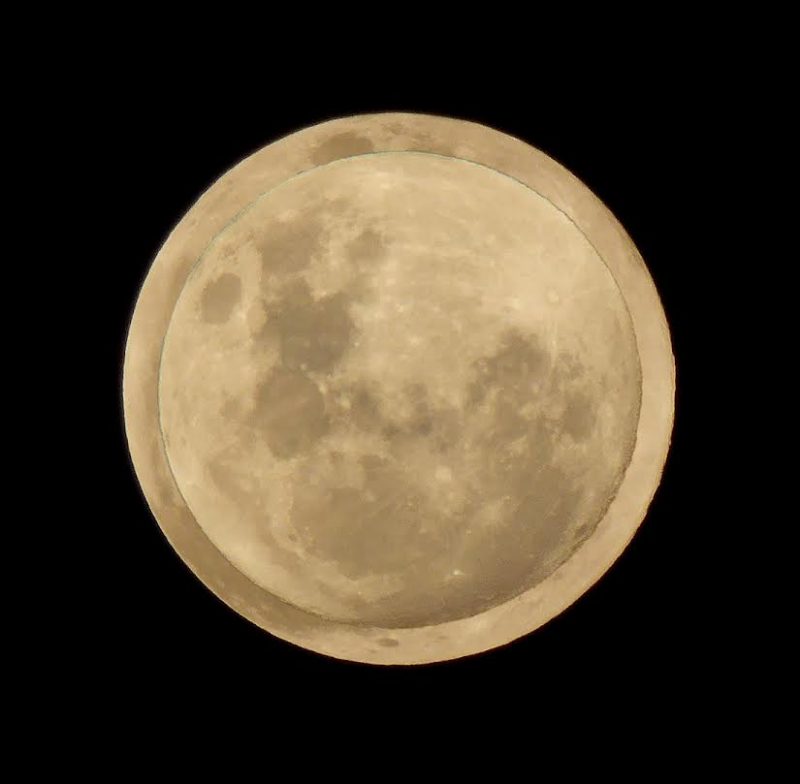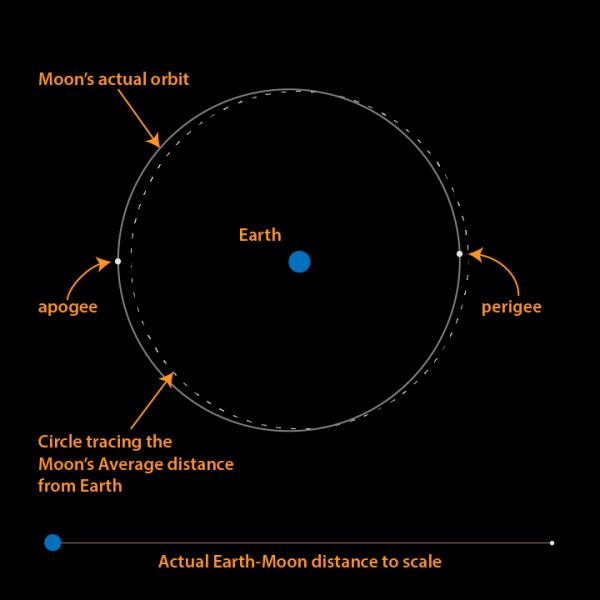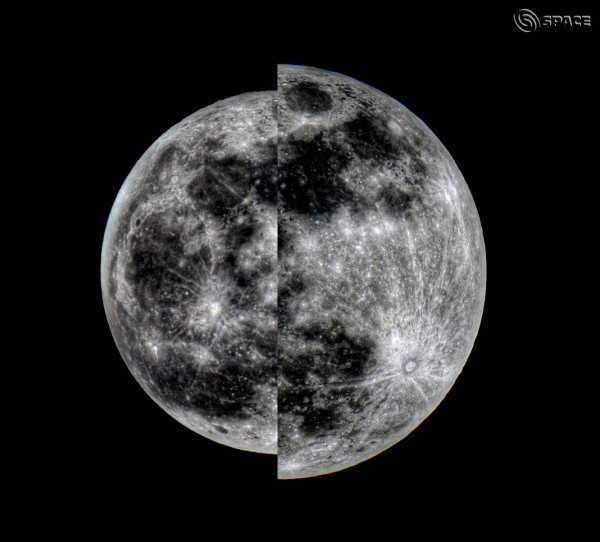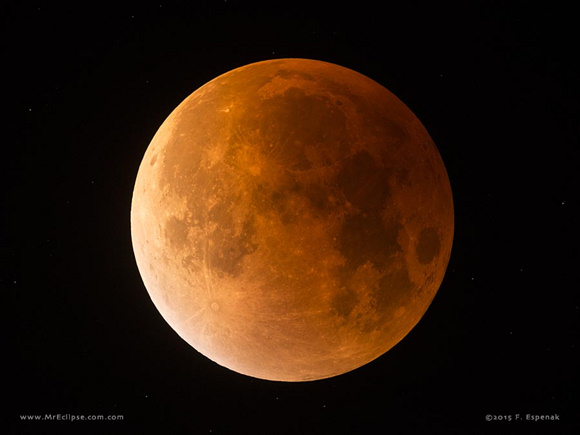
Looking back a year ago to 2015’s closest and largest supermoon on September 28 – and looking ahead to 2016’s closest and largest supermoon on November 14, 2016 – it’s possible to note an intriguing relationship between these supermoons and the famous 18.03-year Saros cycle of eclipses. Follow the links below to learn more.
Perigee and proxigee full moons
September 2015 supermoon and the cycle of proxigee moons
Next total eclipse of a proxigee full moon
Total eclipses of proxigee full moons in the 21st century

Perigee and proxigee full moons. Lunar perigee marks the moon’s nearest point to Earth in its monthly orbit around our planet. Before the term supermoon entered the popular lexicon, astronomers called (and still call) the close coincidence of full moon with perigee a perigee full moon.
Also, sometimes, the year’s closest perigee is called proxigee. That makes the September 2015 and November 2016 full moons – closest in their respective years – proxigee full moons.

September 2015 supermoon and the cycle of proxigee moons. One year ago – on September 28, 2015 – the full moon aligned with lunar perigee to present the closest and largest supermoon of 2015 – and a total lunar eclipse to boot.
The coincidence of full moon and lunar perigee was especially close in September 2015, with the two occurring only about one hour apart.
In 2015, the closest perigee (proxigee) on September 28 found the moon at 356,877 km (221,753 miles) and the farthest apogee on September 14 at 406,464 km (252,565 miles).
The variation in the moon’s distance is a little greater in 2016 than it was in 2015. At its closest on November 14, 2016, the moon is 221,524 miles (356,509 km) away.
Meanwhile, in 2016, the moon’s farthest apogee – the farthest of 2016’s farthest monthly points – is October 31, 2016. The moon will be 406,662 km (252,688 miles) away.
Proxigee full moons often recur in cycles of 14 lunar (synodic) months, because 14 lunar months almost exactly equal 15 returns to perigee (moon’s closest point to Earth). A lunar month refers to the time period between successive full moons, a mean period of 29.53059 days.
An anomalistic month measures successive returns to perigee, a mean period of 27.55455 days.
Hence:
14 lunar months (full moon to full moon) x 29.53059 days = 413.428 days
15 anomalistic months (perigee to perigee) x 27.55455 days = 413.318 days
So there’s about a 413 time period between successive proxigee full moons.

The November 2016 supermoon. The 413-day time period between successive proxigee full moons consists of about 1 year, 1 month and 18 days. That is why the next proxigee full moon (after September 28, 2015) is coming up on November 14, 2016, to feature the closest supermoon since January 26, 1948.
Although the September 2015 full moon was totally eclipsed by the Earth’s dark umbral shadow, the November 2016 full moon will elude the Earth’s shadow by passing to the south of it. Obviously, the cycle of lunar proxigee – and the cycle of lunar eclipses – aren’t equivalent from year to year.

Next total eclipse of a proxigee full moon. There is a cycle that’ll let us know when the next total eclipse of a proxigee full moon will take place. Read on…
The first total eclipse of the proxigee full moon in the 21st century (2001 to 2100) fell on September 28, 2015. We now use the Saros eclipse cycle to tell us when the next total eclipse of the proxigee full moon will be.
The Saros eclipse cycle represents a period of approximately 6,585.3 days (18 years 11 days 8 hours).
One Saros cycle of 223 lunar months almost exactly equals 239 returns to perigee and 242 returns to the same node (point where moon’s orbit intersects Earth’s orbital plane).
223 lunar months (full moon to full moon) x 29.53059 = 6,585.3216 days
239 anomalistic months (perigee to perigee) x 27.55455 = 6,585.5375 days
242 draconic months (node to node) x 27.21222 = 6,585.3572 days
Thus, the next total eclipse of the proxigee full moon will happen on October 8, 2033. The moon will turn full on October 8, 2033, at 10:58 UTC, and then the moon swings to lunar perigee about one and one-quarter hours later, at 12:11 UTC.

Total eclipses of proxigee full moons in the 21st century.
The total lunar eclipses of September 28, 2015, and October 8, 2033, both belong to Saros Series 137. Fortunately, the NASA eclipse web site catalogs all the lunar eclipses in Saros Series 137, so we can easily list all the total eclipses of the proxigee full moon in the 21st century (2001 to 2100):
Total eclipses of proxigee full moons
2015 September 28 (full moon: 2:50 UTC; perigee: 1:46 UTC)
2033 October 8 (full moon: 10:58 UTC; perigee: 12:11 UTC)
2051 October 19 (full moon: 19:13 UTC; perigee: 22:41 UTC)
2069 October 30 (full moon: 3:35 UTC; perigee: 9:15 UTC)
2087 November 10 (full moon: 12:05 UTC; perigee: 19:54 UTC)
At this point, we wish to give honorable mentions to the total eclipses of the perigee full moon on January 21, 2019, and May 26, 2021. However, neither one of these total lunar eclipses finds the full moon at proxigee (year’s closest perigee). For more details, check out Saros Series 134 and Saros Series 121 plus this lunar perigee and apogee calculator.
Super-close proxigee full moons
Although we won’t have a total eclipse of the moon in 2016, the closest supermoon (proxigee full moon) since January 26, 1948, will occur on November 14, 2016. Moreover, we can use the Saros cycle to forecast upcoming super-close proxigee full moons. After 2016, the full moons in this Saros Series are less than 356,500 km distant. What a coincidence that these super-close full moons occur in the year following a total eclipse of a proxigee full moon (listed above):
Super-close proxigee full moons in 21st century
2016 November 14 (356,509 km)
2034 November 25 (356,447 km)
2052 DECEMBER 6 (356,424 km)
2070 December 17 (356,441 km)
2088 December 28 (356,499 km)
Final super-close proxigee full moon of 21st century
The final super-close proxigee full moon of the 21st century will fall on January 17, 2098 (356,434 km). That’s about 9 years + 20 days (a period of 112 lunar months or 120 anomalistic months) after the proxigee full moon on December 28, 2088.
We project the Saros cycle into the 22nd century (2101 to 2200), starting with the 2098 proxigee full moon. After the year 2152, the centers of the Earth and moon won’t come to within 356,500 km again until December 27, 2194 (356,498 km).
2098 January 17 (356,434 km)
2116 JANUARY 29 (356,403 km)
2134 February 9 (356,417 km)
2152 February 20 (356,469 km)
2170 March 3 (356,561 km)
2188 March 13 (356,693 km)
Resources:
Phases of the moon: 2001 to 2100
Moon at perigee and apogee: 2001 to 2100
Lunar perigee and apogee calculator
Full moon at perigee (supermoon): 2001 to 2100











